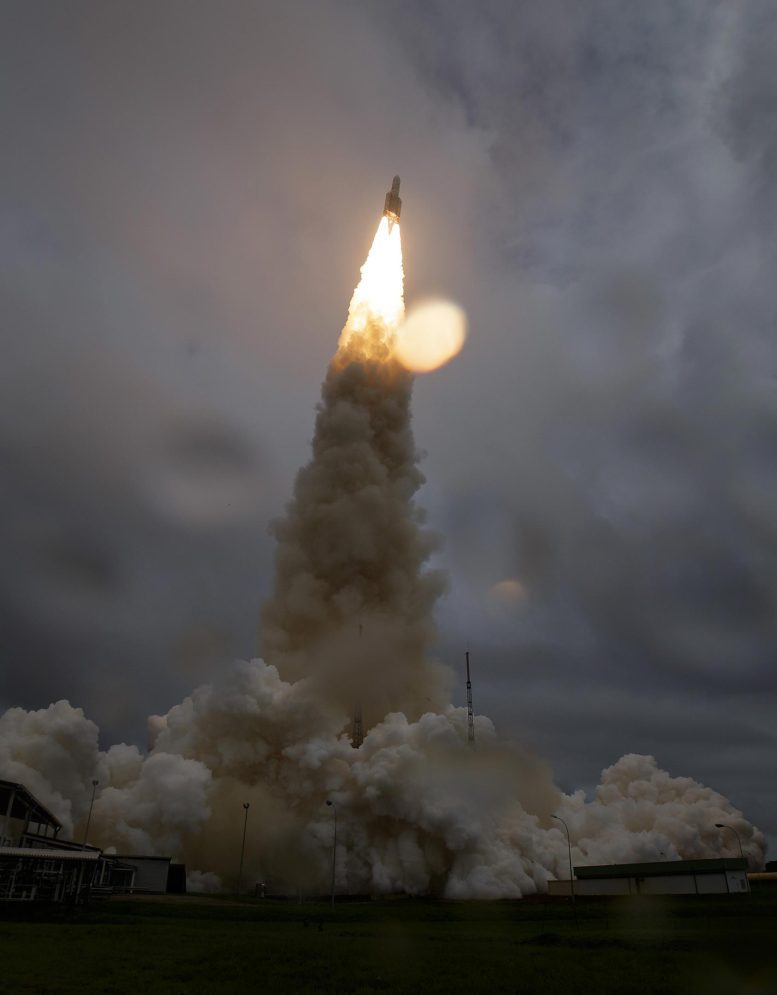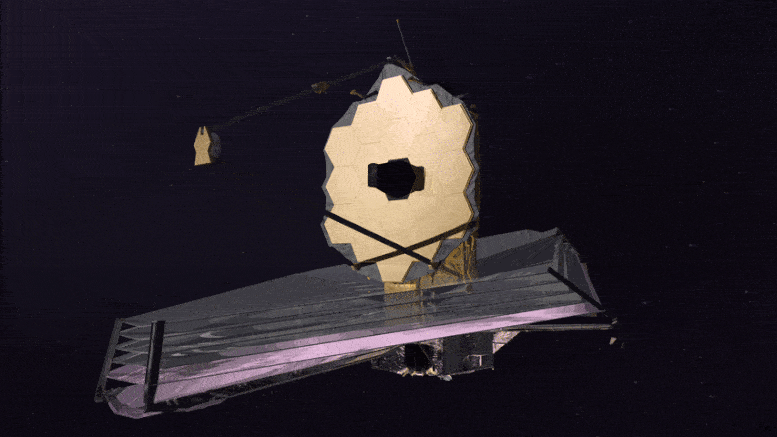NASA successfully launched the biggest and most powerful space telescope ever built on December 25 from Earth.
The James Webb Space Telescope (JWST) will use unparalleled technology to see both close and far, from our solar system’s planets and bodies to the farthest regions of space, where the first stars and galaxies originated over 13 billion years ago.
JWST has a mirror that is 21.3 feet (6.5 meters), making it much larger than Hubble and Hubble’s infrared sister telescope, the Spitzer Space Telescope, which is conducted by Caltech’s IPAC; it also has state-of-the-art photon sensors that record a wider range of wavelengths and enable deeper and more detailed views than Spitzer.
The launch is a significant milestone for the project, which started construction in 2004.
Following launch, the telescope embarked on a one-month journey to its observation perch beyond the moon, an orbital region in space known as the second Lagrange point, or L2, which is about 1 million miles from Earth.
JWST will next begin a six-month post-launch commissioning procedure in which it will unfold its mirrors, sun-shield, and other systems, as well as cool down, align, and calibrate.
The ‘seven minutes of terror’—the time frame in which everything needs to happen perfectly for the landing—is something they have with the Mars missions, as stated by Charles Beichman, senior faculty associate in astronomy and head of the NASA Exoplanet Science Institute at Caltech.
He added it’s a kind of 29 days of worry for JWST for everything to go properly.
Beichman, whose major study interest is exoplanets, is a member of the scientific team for one of JWST’s equipment, the Near Infrared Camera (NIRCam).
NIRCam will detect light from the first stars and galaxies as they develop, as well as populations of stars in adjacent galaxies, young stars in our Milky Way galaxy, planets circling nearby stars, and Kuiper Belt objects on the outskirts of our solar system.
Beichman and the NIRCam team will hunt for Saturn-sized exoplanets circling bright, nearby stars such as epsilon Eri and Vega using a pair of coronagraphic masks produced at the Jet Propulsion Laboratory (JPL), which Caltech oversees for NASA.
NIRCam is one of four key JWST sensors that can be used to look at the sky at different wavelengths
In addition to Mid-Infrared Instrument (MIRI), the other three instruments are the Near Infrared Spectrograph (NIRSpec), the Fine Guidance Sensor/Near Infrared Imager and Slitless Spectrograph (FGS/NIRISS), and the Fine Guidance Sensor/Near Infrared Imager and Slitless Spectrograph (FGS/NIRISS). The first JPL collaborates with the European Space Agency on the MIRI instrument and is able to observe faintly visible comets, Kuiper Belt objects and the light of distant galaxies, newly forming stars. The second will perform high-resolution spectroscopic observations of 100 cosmic objects at the same time.
Caltech researchers are already among those authorized to undertake observations after the telescope has been completed.
Beichman and an international team of researchers have received permission to observe Alpha Centauri, the closest sun-like star to the earth, and decide if it has a planet orbiting it—specifically, a gas planet the size of Jupiter—in association with Professor of Astronomy Dimitri Mawet, who is also a JPL research expert, and Caltech postdoctoral scholar Jorge Llop Sayson.

Future Telescopes Will Search for the Tinniest planets
The distance between Alpha Centauri and Earth is just 4.3 light-years.
The telescope will also be used to study the composition and physical features of exoplanets.
Heather Knutson, Caltech Professor of Planetary Science, will utilize the MIRI instrument with a team lead by graduate student Michael Zhang (MS ’18) to examine an ultra-hot planet smaller than the Earth whirling around a neighboring star in an eight-hour orbit.
Other observers want to utilize the MIRI instrument to assess the atmospheric compositions of possibly habitable Earth-like planets in the TRAPPIST-1 system observed by the Spitzer Space Telescope for the first time.
Overall, Caltech and JPL planetary researchers were successful in obtaining JWST time to investigate exoplanets, including postdoctoral scholar Jessica Spake, visiting associate Renyu Hu, also of JPL, and JPL researcher Tiffany Kataria.
Caltech scientists will utilize JWST to perform cosmological measurements and investigate distant galaxies in addition to studying exoplanets.
IPAC Staff Scientist Andreas Faisst and his colleagues, for example, will employ the NIRCam and MIRI detectors to explore a region of sky known as COSMOS.
Just a few stars obscure the view of this region; it was captured by Hubble and Spitzer, and follow-up data from the Keck telescopes and other ground-based observatories were brought to study how galaxies are impacted by both their fundamental physical properties and the environment that surrounds them—a kind of nature versus nurture study in galactic development.
Faisst said JWST is expected to build on that work by providing imaging data with unprecedented spatial resolution to study the structure of distant galaxies and local places of star formation in them, as well as to find and characterize the very first galaxies in our universe from more than 13.5 billion years ago.
He added it will also alter our knowledge of the universe’s most massive galaxies, answering the puzzle of why some of them have ceased generating stars.
Beichman adds that JWST is revolutionary in its ability to examine a broad variety of objects both close and far, from those in our solar system to those in the furthest reaches of the cosmos.
It will provide unparalleled capabilities to the whole astronomical and solar system communities, as stated by Faisst. In comparison to any prior ground-based or space-based telescope, JWST offers a revolutionary capacity to acquire both pictures and spectra at infrared wavelengths.












Leave a Reply